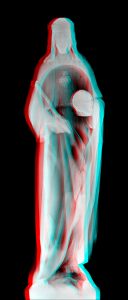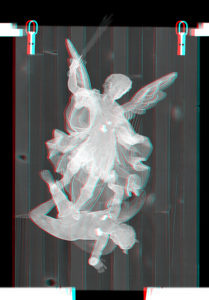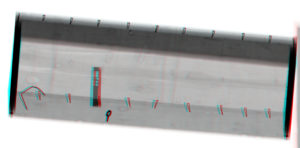X-raying in 3D
Product
Stereoscopic 3D X-ray images
X-ray images of complex objects such as sculptures, plastic works and furniture pieces can be challenging to comprehend, particularly when their internal structure is unknown. This is because all details of the object are projected onto a flat plane, causing them to overlap. In this projection, depth information is lost, so the viewer can no longer easily see where each detail is located within the object.
This is where our 3D option comes in. Art X-Ray machines with this feature have two line-scan X-ray cameras instead of just one. During the scan, the two cameras simultaneously capture the object from two slightly different angles. The result is a stereoscopic 3D X-ray image. On a special 3D monitor, the viewer then no longer sees a "flat" 2D X-ray image, but a three-dimensional transparent object with spatial depth.
The evaluation of X-ray images is greatly simplified by the 3D representation. With 2D images, the viewer must first understand where and how each edge of the object is depicted in the image. In contrast, the structure of the object becomes directly apparent in a 3D image, without having to think about it.
On this page we show some 3D images in anaglyph. To view them you need red-cyan 3D glasses, which we will be happy to send you by post.
Please note, that the red-cyan images shown here are just a first impression. Image quality and depth impression offered by modern 3D monitors is significantly better. If you’d like to see the difference between a 2D and a 3D image, just shut one of your eyes.

In the 3D image of this plaster statue, details such as facial features, insignia and the posture of the hand come out beautifully.

The front and back of this clay statue are patterned. In the 2D image, the patterns are overlaped and jumbled together, whereas in the 3D image the patterns remain spatially separated. The exact course of the crack in the base plate is also visible in the 3D image.
In the 3D image of this plaster statue, details such as facial features, insignia and the posture of the hand come out beautifully.
The front and back of this clay statue are patterned. In the 2D image, the patterns are overlaped and jumbled together, whereas in the 3D image the patterns remain spatially separated. The exact course of the crack in the base plate is also visible in the 3D image.


The X-ray image shows a simple wooden box. Although it has no artistic or historical significance, it is still an interesting example of stereoscopic 3D X-ray imaging: the 2D X-ray image only shows various metal items (clamps, brackets, eyelets). But it takes a 3D image to show the location and position of these items.
The X-ray image shows a simple wooden box. Although it has no artistic or historical significance, it is still an interesting example of stereoscopic 3D X-ray imaging: the 2D X-ray image only shows various metal items (clamps, brackets, eyelets). But it takes a 3D image to show the location and position of these items.
